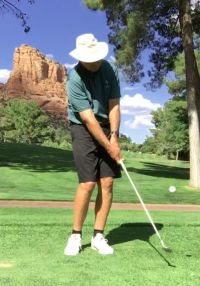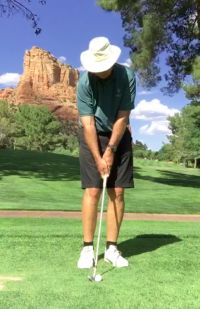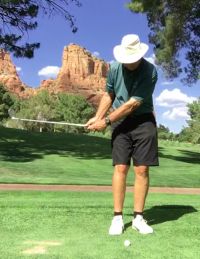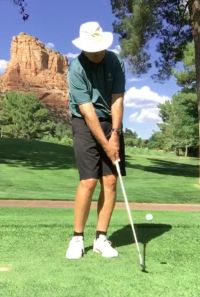June 10, 2022
Let The Club Do The Work
 "Let the club do the work". What does that mean? We have an implement, the golf club, in our hands that is supposed to help us get the ball in the air and make it travel the right distance. In my over fifty years of playing and teaching this game, I rarely see someone "swing the club" and let the club do what it was designed to do. When I do witness this, it is such a pleasure and a beauty to behold.
"Let the club do the work". What does that mean? We have an implement, the golf club, in our hands that is supposed to help us get the ball in the air and make it travel the right distance. In my over fifty years of playing and teaching this game, I rarely see someone "swing the club" and let the club do what it was designed to do. When I do witness this, it is such a pleasure and a beauty to behold.
The person that is associated with the term "swing the clubhead" is the famed teacher, Ernest Jones. Ernest Jones was an English born golf professional, who unfortunately lost his right leg in World War I. In only his second round of golf after coming home from the war he shot an even par 72 over a long and demanding golf course. In the early 1920's, he moved his family to New York to become the head professional at the Women's National Golf and Tennis Club on Long Island. For most of his career, he taught indoor lessons at a studio in New York City. His teaching philosophy centered around what the club should do to create the maximum efficiency to strike the ball solidly. In the simplest of terms, his philosophy was that if the club was swung on the correct path, the body would react according and allow a free flowing motion. In other words, the body reacted to the swinging of the club. He taught many of the great golfers, including Virginia Van Wie, Glenna Collett Vare, Lawson Little, Betty Hicks, Horton Smith and other top players of his era.
Golf clubs have changed dramatically over the past 100 years. Shafts have gone from hickory, to steel, and to graphite and composites. Driver heads are no longer wood, but high tech composites of titanium and carbon fibers. Irons are precision made with heel and toe weighting and enlarged "sweet spots" for greater accuracy. The overall weight of golf clubs has been reduced to allow all players to be able to swing more effortlessly. So why do most golfers not want to take advantage of these improvements?
The club should be swung in the most efficient manner in a nearly circular motion that maximizes speed and control. The players that I see, grip the club too tightly, are ridged and stiff at address, and use the club like a hammer to strike the ball. There is an over-emphasis on positions throughout the swing. Just because you are in an ideal position at the top of your backswing doesn't mean you are guaranteed a good ball strike. What it does mean is that you have a better chance of a good shot, but only if you return the club correctly back to the ball. That is where you must let the "club swing".
First, don't get me wrong, there are fundamentals that should be followed in order to properly set you up for a proficient swing. Don't neglect the proper grip, correct posture, balanced stance, etc., because they give you a better chance of repeating a rhythmical swing. But to "let the club do the work" the most effectively, the club needs to be swung with a free flowing motion that is unhindered by thinking about positions.
Besides putting, the shortest and easiest swing is a chip or pitch. This action requires little body involvement and the distance is dictated by the motion of the club. Since the body is very quiet, the source of power comes only from the length of the backswing and the force of the arms and hands swinging the club. The pro's you see on television each week are infinitely better than the average player when it comes to shots around the green. What they do better than others, is that they let the "club do the work". There is no great force applied, no excessive acceleration to impact, and no added energy other than what is provided by the swinging of the club.
Short shots around the green are "feel" shots. Visualization of and sensing the correct distance is a learned trait. I will assume that you have the proper fundamentals; stance, ball position, posture, arms/hands relaxed, and club shaft at 90 degrees or very slightly forward leaning. Now you need to create enough energy to make the ball go the proper distance. Swinging the club back to a point on the backswing will generate the energy or force that is needed to strike the ball on the downswing. When the club has reached the end of the backswing for a pitch or chip, whether its two feet back or four feet back, the club is at rest. At this point the club is "dead weight". It then has to be started on its path back to the ball. The power/inertia that was created by taking the club to this position will now be used, along with gravity, to swing the club back to the ball. The ball is a stationary object and will have resistance when the club strikes it. Therefore there will be a loss of power as this energy is transferred to the golf ball and the result will be the club stopping short of matching the length of the backswing on the follow-through.
To better your chipping and pitching, do this drill. Ideally go to a practice green where you have forty to sixty feet of green to hit to. Take a seven iron, pitching wedge, and a 56 degree sand wedge. Place a marker at 20, 40, and 60 feet. Using the seven iron first, take the club back far enough so you do not exert any added pressure or force. It is almost like you are dropping the club back to the ball. You are using the weight of the club to strike the ball. After you get the feel for the short distance, go to the next, and then try with different clubs. The next step would be to increase distance to 20, 40, and 60 yards. At these distances the body needs to react to the swinging of the club. There will be a small turn of the body on the backswing to accommodate the proper swing path (hopefully, this will happen naturally). Likewise, on the follow-through, the body needs to get out of the way so the club has a path to swing through naturally. There shouldn't be any interference from the body motion, just getting out of the way so the "club can do its work".




Having a free flowing, effective swing takes practice and an understanding of what you are trying to accomplish. By learning the shorter swings and letting the "club swing", will translate to your fuller swings. A great teacher once said, that "Golf is really easy, it's just hard to do". If you are trying too hard and forcing the club to work, try this simple drill and you will understand what it means to "let the club do the work".



